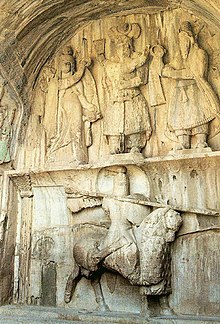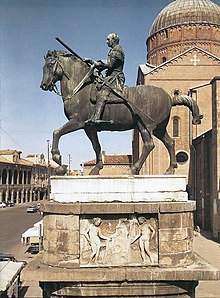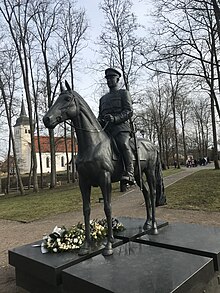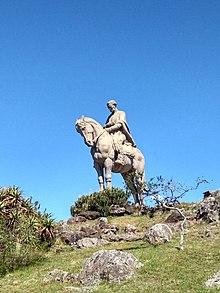Equestrian statue
Anequestrian statueis astatueof a rider mounted on ahorse,from theLatineques,meaning 'knight', deriving fromequus,meaning 'horse'.[1]A statue of a riderless horse is strictly anequine statue.A full-sized equestrian statue is a difficult and expensive object for any culture to produce, and figures have typically been portraits of rulers or, in the Renaissance and more recently, military commanders.
History[edit]

Ancient Greece[edit]
Equestrian statuary in the West dates back at least as far asArchaic Greece.Found on theAthenian acropolis,the sixth-century BC statue known as theRampin Riderdepicts akourosmounted on horseback.
Ancient Middle and Far East[edit]
A number of ancientEgyptian,AssyrianandPersianreliefsshow mounted figures, usually rulers, though no free-standing statues are known. The ChineseTerracotta Armyhas no mounted riders, though cavalrymen stand beside their mounts, but smallerTang dynastypottery tomb Qua figures often include them, at a relatively small scale. No Chinese portrait equestrian statues were made until modern times; statues of rulers are not part of traditional Chinese art, and indeed even painted portraits were only shown to high officials on special occasions until the eleventh century.[2]
Ancient Rome[edit]

Such statues frequently commemorated military leaders, and those statesmen who wished tosymbolicallyemphasize the active leadership role undertaken since Roman times by the equestrian class, theequites(plural ofeques) or knights.
There were numerousbronzeequestrian portraits (particularly of the emperors) inancient Rome,but they did not survive because they were melted down for reuse of the alloy ascoin,church bells,or other, smaller projects (such as new sculptures for Christian churches); the standingColossus of Barlettalost parts of his legs and arms to Dominican bells in 1309. Almost the only sole survivingRomanequestrian bronze, theequestrian statue of Marcus Aureliusin Rome, owes its preservation on theCampidoglio,to the popular misidentification ofMarcus Aurelius,the philosopher-emperor, withConstantine the Great,the Christian emperor. TheRegisole( "Sun King" ) was a bronze classical or Late Antique equestrian monument of a ruler, highly influential during the Italian Renaissance but destroyed in 1796 in the wake of theFrench Revolution.It was originally erected atRavenna,but moved toPaviain the Middle Ages, where it stood on a column before the cathedral. A fragment of an equestrian portrait sculpture ofAugustushas also survived.
Medieval Europe[edit]
Equestrian statues were not very frequent in theMiddle Ages.Nevertheless, there are some examples, like theBamberg Horseman(German:Der Bamberger Reiter), inBamberg Cathedral.Another example is theMagdeburg Reiter,in the city ofMagdeburg,that depicts EmperorOtto I.There are a few roughly half-size statues ofSaint George and the Dragon,including the famous ones inPragueandStockholm.TheScaliger TombsinVeronainclude Gothic statues at less than life-size. A well-known small bronzeequestrian statuette of Charlemagne(or another emperor) in Paris may be a contemporary portrait ofCharlemagne,although its date and subject are uncertain.
-
Bamberg Horseman(1225–1237), Bamberg
-
MagdeburgHorseman (1240), Magdeburg
-
St. George and dragon (1373), Prague
-
Tilman Riemenschneider:Hl Georg (1490–1495), Bode Museum
Renaissance[edit]

After the Romans, no surviving monumental equestrian bronze was cast in Europe until 1415–1450, whenDonatellocreated the heroic bronzeequestrian statue of Gattamelatathecondottiere,erected inPadua.In fifteenth-century Italy, this became a form to memorialize successful mercenary generals, as evidenced by the painted equestrian funerary monuments toSir John HawkwoodandNiccolò da TolentinoinFlorence Cathedral,and thestatue of Bartolomeo Colleoni(1478–1488) cast byVerrocchioinVenice.
Leonardo da Vincihad planned acolossal equestrian monument to the Milanese ruler, Francesco Sforza,but was only able to create a clay model. The bronze was reallocated for military use in theFirst Italian War.[3]Similar sculptures have survived in small scale:The Wax Horse and Rider(c. 1506–1508) is a fragmentary model for an equestrian statue ofCharles d'Amboise.[4]TheRearing Horse and Mounted Warriorin bronze was also attributed to Leonardo.
Titian's equestrian portrait ofCharles V, Holy Roman Emperor,of 1548 applied the form again to a ruler. Theequestrian statue of Cosimo Ide' Medici (1598) byGiambolognain the center ofFlorencewas a life size representation of the Grand-Duke, erected by his son Ferdinand I.
Ferdinand himself would be memorialized in 1608 with an equestrianstatue in Piazza della Annunziatawas completed by Giambologna's assistant,Pietro Tacca.Tacca's studio would produce such models for the rulers in France and Spain. His last public commission was the colossal equestrian bronze ofPhilip IV,begun in 1634 and shipped to Madrid in 1640. In Tacca's sculpture, atop a fountain composition that forms the centerpiece of the façade of the Royal Palace, the horse rears, and the entire weight of the sculpture balances on the two rear legs, and discreetly, its tail, a novel feat for a statue of this size.
-
Bernt Notke:St George and the Dragon(1489), bronze replica of wooden sculpture, Stockholm
-
Pietro Tacca:Monument to Philip IV of Spain(1634–1640)
Absolutism[edit]

During the age ofAbsolutism,especially inFrance,equestrian statues were popular with rulers;Louis XIVwas typical in having one outside hisPalace of Versailles,and the over life-size statue in thePlace des Victoiresin Paris byFrançois Girardon(1699) is supposed to be the first large modern equestrian statue to be cast in a single piece; it was destroyed in theFrench Revolution,though there is a small version in theLouvre.The near life-size equestrian statue ofCharles I of EnglandbyHubert Le Sueurof 1633 atCharing Crossin London is the earliest large English example, which was followed by many. The equestrian statue of KingJosé I of Portugal,in thePraça do Comércio,was designed byJoaquim Machado de Castroafter the1755 Lisbon earthquakeand is a pinnacle of Absolutist age statues in Europe. TheBronze Horseman(Russian:Медный всадник,literally "The Copper Horseman" ) is an iconic equestrian statue, on a huge base, ofPeter the Greatof 1782 byÉtienne Maurice FalconetinSaint Petersburg,Russia.The use of French artists for both examples demonstrates the slow spread of the skills necessary for creating large works, but by the nineteenth century most large Western countries could produce them without the need to import skills, and most statues of earlier figures are actually from the nineteenth or early twentieth century.

United States[edit]
In the colonial era, an equestrian statue ofGeorge IIIby English sculptorJoseph Wiltonstood onBowling GreeninNew York City.This was the first such statue in the United States, erected in 1770 but destroyed on July 9, 1776, six days after theDeclaration of Independence.[5]The 4,000-pound (1,800 kg) gilded lead statue was toppled and cut into pieces, which were made into bullets for use in theAmerican Revolutionary War.[6]Some fragments survived and in 2016 the statue was recreated for a museum.[7]
In the United States, the first three full-scale equestrian sculptures erected wereClark Mills'Andrew Jackson(1852) inWashington, D.C.;Henry Kirke Brown'sGeorge Washington(1856) inNew York City;andThomas Crawford's George Washington inRichmond, Virginia(1858). Mills was the first American sculptor to overcome the challenge of casting a rider on a rearing horse. The resulting sculpture (of Jackson) was so popular he repeated it forNew Orleans,Nashville,andJacksonville.
Cyrus Edwin Dallinmade a specialty of equestrian sculptures of American Indians: hisAppeal to the Great Spiritstands before theMuseum of Fine Arts,Boston.TheRobert Gould Shaw Memorialin Boston is a well-knownreliefincluding an equestrian portrait.
Twentieth century[edit]

As the twentieth century progressed, the popularity of the equestrian monument declined sharply, as monarchies fell and the military use of horses virtually vanished. Thestatue of Queen Elizabeth II riding BurmeseinCanada,and statues ofRani LakshmibaiinGwaliorandJhansi,India, are some of the rare portrait statues with female riders. (AlthoughJoan of Archas been so portrayed a number of times,[8]and anequestrian statue of Queen Victoriafeatures prominently inGeorge Square,Glasgow). In America, the late 1970s and early 1980s witnessed something of a revival in equestrian monuments, largely in theSouthwestern United States.There, art centers such asLoveland, Colorado,Shidoni Foundry inNew Mexico,and various studios inTexasonce again began producing equestrian sculpture.

These revival works fall into two general categories, the memorialization of a particular individual or the portrayal of general figures, notably the AmericancowboyorNative Americans.Such monuments can be found throughout the American Southwest.
In Glasgow, the sculpture of Lobey Dosser on El Fidelio, erected in tribute toBud Neill,is claimed to be the only two-legged equestrian statue in the world.
Tallest and largest equestrian statue[edit]

The monument to generalJose Gervasio ArtigasinMinas, Uruguay(18 meters tall, 9 meters long, 150,000 kg), was the world's largest equestrian statue until 2008. The current largest is the 40-meter-tallequestrian statue of Genghis Khanat Boldog, 54 km fromUlaanbaatar,Mongolia,where, according to legend,Genghis Khanfound thegolden whip.
TheMarjing Polo Statue,standing in theMarjing Polo Complex,Imphal East,Manipur(122 feet (37 m) tall[a][9][10]), completed in 2022–23, is the world's tallest equestrian statue of apoloplayer. It depicts ancient Meitei deityMarjing,aMeitei horse (Manipuri pony)andSagol Kangjei(Meiteifor 'polo').[11][12]
The world's largest equestrian sculpture, when completed, will be theCrazy Horse MemorialinSouth Dakota,at a planned 641 feet (195 m) wide and 563 feet (172 m) high, even though only the upper torso and head of the rider and front half of the horse will be depicted. Also on a huge scale, the carvings onStone MountaininGeorgia,the United States, are equestrian sculpture rather than true statues, the largestbas-reliefin the world. The world's largest equestrianbronzestatues are theJuan de Oñatestatue (2006) inEl Paso, Texas;a 1911 statue inAltare della PatriainRome;and thestatue of Jan Žižka(1950) inPrague.[13]
Other statues of particular note[edit]
- Memorial atVlamertingeto commemorate the one million horses killed in WW1
- Memorial of CaptainEdward CheneyatGaddesbyshowing him on a dying horse – he had five horses shot out from under him at theBattle of Waterlooand led the charge of theRoyal Scots Greys– the only equestrian statue in a British church
- Memorial to "Crimean Bob" the last horse to die following service at the Battle of Waterloo, inCahir
- The Kelpies,pair of 30m high horse heads nearFalkirkin Scotland
Hoof-position symbolism[edit]

In many parts of the world, anurban legendstates that if the horse is rearing (both front legs in the air), the rider died in battle; one front leg up means the rider was wounded in battle; and if all four hooves are on the ground, the rider died outside battle. A rider depicted as dismounted and standing next to their horse often indicates that both were killed during battle.[14]For example,Richard the Lionheartis memorialised, mountedpassant,outside thePalace of WestminsterbyCarlo Marochetti;the former died 11 days after his wound, sustained in siege, turned septic. A survey of 15 equestrian statues in central London by theLondonistwebsite found that nine of them corresponded to the supposed rule, and considered it "not a reliable system for reading the fate of any particular rider".[15]
In the United States, the rule is especially held to apply to equestrian statues commemorating theAmerican Civil Warand theBattle of Gettysburg,.[16][17]One such statue was erected in 1998 inGettysburg National Military Park,and is ofJames Longstreet,who is featured on his horse with one foot raised, even though Longstreet was not wounded in that battle. However, he was seriously wounded in theBattle of the Wildernessthe following year. This is not a traditional statue, as it does not place him on apedestal.One writer claims that any correlation between the positioning of hooves in a statue and the manner in which a Gettysburg soldier died is a coincidence.[18]There is no proper evidence that these hoof positions correlate consistently with the rider's history but some hold to the belief regardless.[19][20]
See also[edit]
Notes[edit]
- ^Many news websites mislead the height as "110 feet", "120 feet", etc.
References[edit]
- ^Wheelock, Frederic M.,The Official Wheelock's Latin Website,retrieved2009-04-03
- ^Stuart, Jan & Rawski, Evelyn Sakakida.Worshiping the ancestors: Chinese commemorative portraits,Stanford University Press, 2001,ISBN0-8047-4263-4,ISBN978-0-8047-4263-4
- ^Kemp, Martin (2007).Leonardo da Vinci: The Marvellous Works of Nature and Man.Oxford University Press. pp. 201–203.ISBN9780199207787.
- ^The statue now in London putatively by Leonardo himself according toCarlo Pedretti.
- ^"Equestrian Statues".Art and Progress.4(8): 995–998. 1913.JSTOR20560907.
- ^"King George's Head".The Connecticut Society of the Sons of the American Revolution.Archived from the original on March 22, 2015.RetrievedAugust 24,2019.
{{cite web}}:CS1 maint: unfit URL (link) - ^Dunlap, David W. (October 20, 2016)."Long-Toppled Statue of King George III to Ride Again, From a Brooklyn Studio".The New York Times.RetrievedAugust 24,2019.
- ^Joan of Arc (Jeanne d'Arc) (1412–1431): Statues and Monuments
- ^"Union Home and Cooperation Minister Shri Amit Shah inaugurated and laid the foundation stone of 21 development projects worth Rs. 1,311 crore at Moirang, Manipur today".pib.gov.in.Retrieved2023-01-10.
Shri Amit Shah inaugurated Medical College of worth Rs. 46 Crore at Churachandpur and unveils 122 feet tall Marjing polo statue of worth Rs. 39 crore
- ^"Manipur: Union Home Minister Amit Shah inaugurates 122-feet-high Marjing Polo statue".India Today NE.2023-01-06.Retrieved2023-01-10.
- ^"Manipur: Amit Shah will unveil the tallest statue of the polo player, will hoist the tricolor at the historic site – News8Plus-Realtime Updates On Breaking News & Headlines".2023-01-06.Retrieved2023-01-10.
- ^"World's tallest polo statue to be constructed in Mnp | Nagaland Post".28 April 2016.Retrieved2023-01-10.
- ^World's Largest Equestrian Bronze Statue Installed
- ^Dupré, Judith (2007).Monuments: America's History in Art and Memory(1st ed.). New York:Random House.p. 9.ISBN978-1-4000-6582-0.OCLC70046094.
- ^"Do London's Horse Statues Follow a Hidden Code?".2016-07-20.
- ^Mikkelson, Barbara (2 August 2007)."Statue of Limitations".Snopes.com.
- ^"Gettysburg Monument Series – the Horse Hoof Question: An Enduring Myth".20 July 2012.
- ^Adams, Cecil (6 October 1989)."In statues, does the number of feet the horse has off the ground indicate the fate of the rider?".The Straight Dope.
- ^Hiskey, Daven (12 February 2013)."The Way a Soldier's Horse is Portrayed in an Equestrian Statue Has Nothing to Do With How The Soldier Died".Today I Found Out.
- ^Wilde, Robert."Historical Myths: Common Codes Supposedly Hidden In Statues".About.com.Archived fromthe originalon 2015-04-16.Retrieved2015-04-15.
Bibliography[edit]
- Joachim Poeschke, Thomas Weigel, Britta Kusch-Arnhold (eds.),Praemium Virtutis III – Reiterstandbilder von der Antike bis zum Klassizismus.Rhema-Verlag, Münster 2008,ISBN978-3-930454-59-4
- Raphael Beuing:Reiterbilder der Frührenaissance – Monument und Memoria.Rhema-Verlag, Münster 2010,ISBN978-3-930454-88-4








